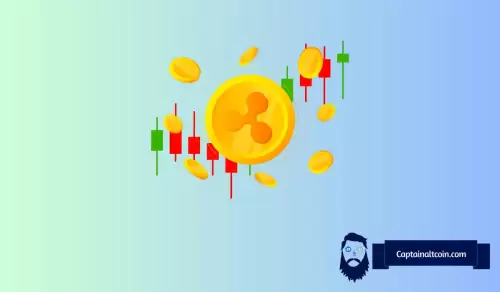 |
|
 |
|
 |
|
 |
|
 |
|
 |
|
 |
|
 |
|
 |
|
 |
|
 |
|
 |
|
 |
|
 |
|
 |
|
Cryptocurrency News Articles
Tim Berners-Lee's vision of the World Wide Web is dead
May 02, 2025 at 11:04 pm
Tim Berners-Lee’s vision of the World Wide Web as an open and accessible global information system has been overrun by centralized global data conglomerates which restrict free speech and monetize your data as a price of entry.
This is the vision of Web2 where Web2 firms have built walled gardens with massive information asymmetry between companies and users.
However, blockchain-based decentralized technology challenges the status quo to present an alternative to Web2’s closed-source infrastructure.
It enables developers and engineers to build a censorship-resistant and accessible open-data web to champion the cause of free speech. Open-source technology creates a paradigmatic shift in a fair and inclusive internet where centralized web companies won’t dictate the terms.
A vision deferred
In 1989, Berners-Lee’s invention was to create a virtual space for collaboration, sharing and learning from one another. The web’s first iteration was based on openness, where anyone could contribute, access information, work together, and enjoy the same opportunities.
Fast forward to 2025, and the internet is no longer free. Capital’s brute force has emboldened centralized companies to exercise authoritarian control over data and information flows.
Unfortunately, these companies have acquired their power and resources from unaware users who unknowingly contributed to their capital accumulation strategies. Web2 companies surreptitiously collect data from users without fair compensation and use that as a weapon to control user behavior.
Corporations harness user data to train opaque algorithms and deploy information “discoverability” to shape users’ beliefs and emotions. This practice is mainly visible on centralized social media platforms such as Facebook, Instagram and X, with multiple scandals and pending litigations eroding user trust.
For instance, in June 2024, 11 European Union members submitted complaints against Meta, the parent company of Facebook and Instagram. The complaints pertained to using personal data like posts and images without consent to train Meta’s AI models, infringing upon EU privacy laws.
Recent: The case against Pavel Durov and why it’s important for crypto
The Cambridge Analytica scandal demonstrated how companies mine data to shape political perspectives and election outcomes. These companies also construct pre-determined narratives and shape market behavior by promoting or subverting curated reports, sometimes shaping public perspectives on health and economic data.
Under its Digital Markets Act, the European Commission has initiated a noncompliance investigation into Apple, Meta, Amazon and Alphabet’s practices. Meta has also incurred a $1.3 billion fine for failing to comply with privacy regulations.
In this environment, “free speech” remains a far-fetched dream because the entire tech stack is hostile to accessibility and openness. To realize Berners-Lee’s vision, apps must use a decentralized tech stack and be built from the ground up on an open architecture.
Make the internet free (again)
An app’s tech stack consists of its front and back ends, data storage and Content Delivery Network (CDN). Web2 platforms depend on a centralized tech stack that puts free speech at risk, while most blockchain-powered apps leverage a censorship-resistant decentralized tech stack with high uptime.
Some decentralized applications (DApps) build their front end on a decentralized interface. However, most of their back end is still stuck on centralized data infrastructure.
For instance, despite their censorship vulnerabilities and single failure points, decentralized applications (DApps) frequently use centralized cloud providers and data hosting platforms. These types of attack vectors make projects like Tornado Cash subject to the changing moods of state actors.
Shifting to open-source protocols for distributed data storage like InterPlanetary File System (IPFS) and Filecoin sustains the free speech philosophy on DApps. These protocols provide a censorship-resistant, tamper-proof storage facility that remains accessible without arbitrary outages.
DApps also use centralized remote procedure call (RPC) providers to supply data from the back-end to the front-end interface, especially across multiple networks. But any outage or attack, like the one on X, can lead to downtime, inaccuracies, data gaps and disconnected information flows. If it doesn’t seem like much, remember downtime or inaccuracies in decentralized finance can cost billions.
Decentralized protocols avoid these situations by transforming data accessibility and transfer channels with independent node operators. Data queries are distributed across the network, eliminating any single point of failure and providing uninterrupted data availability. More importantly, it safeguards free speech rights because no single node can block or obstruct data flow, and the network remains accessible even if several nodes go offline.
CDNs, yet another crucial component for serving user requests, can become inaccessible due to market pressure or political influence. Opaque decisions from closed-door meetings dictate data flows on CDNs without any certainty in information flows.
Start with the basics
Decentralized protocols remove the need for centralized decision-making by enabling apps to directly access data without intermediaries. These permissionless protocols connect open-source data and service providers with users and applications, removing human
Disclaimer:info@kdj.com
The information provided is not trading advice. kdj.com does not assume any responsibility for any investments made based on the information provided in this article. Cryptocurrencies are highly volatile and it is highly recommended that you invest with caution after thorough research!
If you believe that the content used on this website infringes your copyright, please contact us immediately (info@kdj.com) and we will delete it promptly.
-

-

-

-

-

-

-

-

-

- US Treasury Secretary Declares a $2 Trillion Market Cap for Pegged Stablecoins Is Not Only Feasible – It's Within Reach
- Jun 13, 2025 at 08:50 pm
- On June 11 2025, U.S. Treasury Secretary, Scott Bessent, declared that a $2 trillion market capitalization for U.S. dollar–pegged stablecoins is not only feasible – it’s within reach.





























































